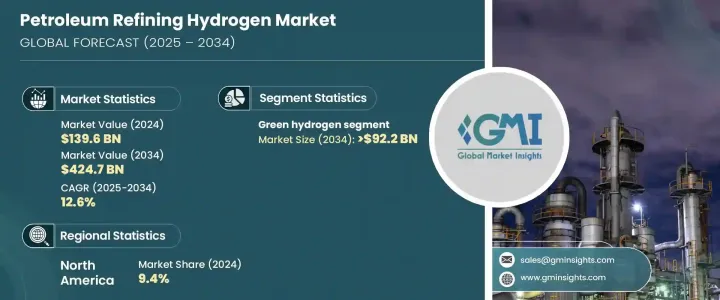PUBLISHER: Global Market Insights Inc. | PRODUCT CODE: 1721433

PUBLISHER: Global Market Insights Inc. | PRODUCT CODE: 1721433
Petroleum Refining Hydrogen Market Opportunity, Growth Drivers, Industry Trend Analysis, and Forecast 2025 - 2034
The Global Petroleum Refining Hydrogen Market was valued at USD 139.6 billion in 2024 and is estimated to grow at a CAGR of 12.6% to reach USD 424.7 billion by 2034. The rapid transformation of the global energy landscape is steering the petroleum refining industry toward sustainable solutions, with hydrogen emerging as a crucial component in this shift. As countries commit to net-zero goals and introduce stricter environmental mandates, refineries are under mounting pressure to lower emissions and adopt cleaner fuel production techniques. Hydrogen plays a pivotal role in meeting these challenges, especially in hydrotreating and hydrocracking processes that are essential for producing ultra-low sulfur diesel (ULSD) and other low-emission fuels.

With global fuel standards becoming increasingly stringent, refineries are actively investing in advanced hydrogen production technologies to maintain competitiveness while supporting sustainability goals. This growing dependency on hydrogen is not only driven by regulatory compliance but also by the demand for high-efficiency operations, greater fuel quality, and improved energy security amid fluctuating oil prices and rising geopolitical risks. The global emphasis on clean energy and circular economies continues to drive investments into hydrogen infrastructure, R&D, and strategic collaborations among leading players.
| Market Scope | |
|---|---|
| Start Year | 2024 |
| Forecast Year | 2025-2034 |
| Start Value | $139.6 Billion |
| Forecast Value | $424.7 Billion |
| CAGR | 12.6% |
The rising demand for ULSD and low-emission fuels, fueled by the global shift toward cleaner energy sources, remains a primary factor accelerating hydrogen demand in petroleum refining. Advanced hydroprocessing technologies that reduce impurities in crude oil are further enhancing hydrogen utilization. Continuous innovations in catalyst performance and process design are enabling higher hydrogen efficiency, allowing refineries to boost the production of high-quality fuels while minimizing environmental impact. As sustainability becomes a business imperative, hydrogen adoption continues to gain traction across the refining sector.
The green hydrogen segment is expected to generate USD 92.2 billion by 2034, as the industry prioritizes decarbonization and the use of renewable energy. Green hydrogen is increasingly preferred due to its zero-emission profile, with refineries aligning operations with international climate frameworks. This trend is reinforced by concerns surrounding fossil fuel dependency and the volatility of global energy markets, driving interest in localized, renewable hydrogen sources to build more resilient supply chains.
The grey hydrogen segment is projected to reach USD 285 billion by 2034, supported by its cost-effectiveness and established infrastructure. Refineries continue to favor grey hydrogen in hydrotreating and hydrocracking processes due to the minimal changes required in existing operations. Its role remains critical in meeting sulfur content regulations while maintaining process efficiency.
The U.S. Petroleum Refining Hydrogen Market, valued at USD 8.8 billion in 2022, is witnessing steady growth amid state and federal initiatives focused on climate neutrality. Investments in electrolysis and hydrogen R&D, backed by public-private partnerships, are helping reduce the cost of green hydrogen and expanding its adoption across U.S. refineries.
Major market players include Shell Global, BP, PetroChina, Reliance Industries, ExxonMobil, Saudi Aramco, Messer Group, Nel Hydrogen, Chevron Corporation, and Indian Oil Corporation. These companies are advancing hydrogen production technologies, increasing production capacities, and forging strategic partnerships to support green hydrogen projects and meet the global demand for cleaner energy.
Table of Contents
Chapter 1 Methodology & Scope
- 1.1 Research design
- 1.2 Base estimates & calculations
- 1.3 Forecast model
- 1.4 Primary research & validation
- 1.4.1 Primary sources
- 1.4.2 Data mining sources
- 1.5 Market definitions
Chapter 2 Executive Summary
- 2.1 Industry synopsis, 2021 - 2034
Chapter 3 Industry Insights
- 3.1 Industry ecosystem
- 3.2 Regulatory landscape
- 3.3 Industry impact forces
- 3.3.1 Growth drivers
- 3.3.2 Industry pitfalls & challenges
- 3.4 Growth potential analysis
- 3.5 Porter's analysis
- 3.5.1 Bargaining power of suppliers
- 3.5.2 Bargaining power of buyers
- 3.5.3 Threat of new entrants
- 3.5.4 Threat of substitutes
- 3.6 PESTEL analysis
Chapter 4 Competitive landscape, 2024
- 4.1 Introduction
- 4.2 Strategic dashboard
- 4.3 Innovation & technology landscape
Chapter 5 Market Size and Forecast, By Type, 2021 - 2034 (USD Billion & MT)
- 5.1 Key trends
- 5.2 Grey
- 5.3 Blue
- 5.4 Green
Chapter 6 Market Size and Forecast, By Region, 2021 - 2034 (USD Billion & MT)
- 6.1 Key trends
- 6.2 North America
- 6.2.1 U.S.
- 6.2.2 Canada
- 6.2.3 Mexico
- 6.3 Europe
- 6.3.1 Germany
- 6.3.2 UK
- 6.3.3 France
- 6.3.4 Italy
- 6.3.5 Netherlands
- 6.3.6 Russia
- 6.4 Asia Pacific
- 6.4.1 China
- 6.4.2 Japan
- 6.4.3 India
- 6.4.4 Australia
- 6.5 Middle East & Africa
- 6.5.1 Saudi Arabia
- 6.5.2 Iran
- 6.5.3 UAE
- 6.5.4 South Africa
- 6.5.5 Qatar
- 6.5.6 Kuwait
- 6.6 Latin America
- 6.6.1 Chile
- 6.6.2 Brazil
- 6.6.3 Argentina
Chapter 7 Company Profiles
- 7.1 BP
- 7.2 ExxonMobil
- 7.3 Chevron Corporation
- 7.4 Indian Oil Corporation
- 7.5 Messer Group
- 7.6 Nel Hydrogen
- 7.7 PetroChina
- 7.8 Reliance Industries
- 7.9 Saudi Aramco
- 7.10 Shell Global




